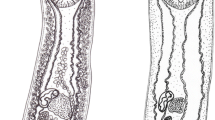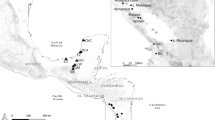Abstract
The taxonomic history and species composition of the genus Clinostomum has been unstable. Two species, Clinostomum complanatum Rudolphi, 1814 and Clinostomum marginatum Rudolphi, 1819, have been particularly problematic and its validity has been disputed for nearly 200 years. In this paper, we have made use of an integrative taxonomy approach, and we used, in first instance, DNA sequences of two genes (cox1 and ITS) to test the validity of C. complanatum, a species apparently widely distributed in Mexico and to link the metacercariae and adult forms of the recognized species of Clinostomum. Combining molecular data with morphology, host association, and geographical distribution, we searched for the potential existence of undescribed species. A new species of Clinostomum is described based on adults found in the mouthy cavity of three species of fish-eating birds as well as in metacercariae found in freshwater and estuarine fishes. A few morphological characteristics distinguish the new species from other congeners even though reciprocal monophyly in a phylogenetic tree based on maximum-likelihood and Bayesian analysis, genetic divergence, and a multivariate analysis of variance and a principal component analysis of 18 morphometric traits for adults and metacercariae demonstrates the validity of the new species. Based on our results, it seems that C. complanatum is not currently distributed in Mexico, although this requires further verification with a more thoroughful sampling in other areas of the country, but it is plausible to support the hypothesis that C. marginatum is the American form, as previously suggested by other authors.





Similar content being viewed by others
References
Agustí CF, Aznar J, Raga A (2005) Tetraphyllidean plerocercoids from western Mediterranean cetaceans and other marine mammals around the world: a comprehensive morphological analysis. J Parasitol 91:83–92
Alcántar-Escalera FJ, García-Varela M, Vázquez-Domínguez E, Pérez-Ponce de León G (2013) Using DNA barcoding to link cystacanths and adults of the acanthocephalan Polymorphus brevis in central Mexico. Mol Ecol Res 9. doi:10.1111/1755-0998
American Ornithologists' Union (AOU) (1998) Check-list of North American birds, 7th edn. American Ornithologists' Union, Washington, DC
Bonett RM, Steffen MA, Trujano-Alvarez AL, Martin SD, Bursey CR, Mcallister CT (2011) Distribution, abundance, and genetic diversity of Clinostomum spp. metacercariae (Trematoda: Digenea) in a modified Ozark stream system. J Parasitol 97:177–184
Bravo-Hollis M (1947) Dos especies de Clinostomum (Trematoda), de aves procedentes del estado de Nuevo León. Anales del Instituto de Biología, México 18:489–498
Caffara M, Locke SA, Gustinelli A, Marcogliese DJ, Fioravanti ML (2011) Morphological and molecular differentiation of Clinostomum complanatum and Clinostomum marginatum (Digenea: Clinostomidae) metacercariae and adults. J Parasitol 97:884–891
Caffara M, Bruni G, Paoletti C, Gustinelli A, Fioravanti ML (2013) Metacercariae of Clinostomum complanatum (Trematoda: Digenea) in European newts Triturus carnifex and Lissotriton vulgaris (Caudata: Salamandridae). J Helminthol. doi:10.1017/S0022149X13000151
Criscione CD, Poulin R, Blouin MS (2005) Molecular ecology of parasites: elucidating ecological and microevolutionary processes. Mol Ecol 14:2247–2257
Dias ML, Eiras JC, Machado MH, Souza GT, Pavanelli GC (2003) The life cycle of Clinostomum complanatum Rudolphi, 1814 (Digenea, Clinostomidae) on the floodplain of the high Paraná river, Brazil. Parasitol Res 89:506–508
Feizullaev NA, Mirzoeva SS (1983) Revision of the Superfamily Clinostomoidea and analysis of its system. Parazitologiya 17:3–11 (in Russian)
Gustinelli A, Caffara M, Florio D, Otachi EO, Wathuta EM, Fioravanti ML (2010) First description of the adult stage of Clinostomum cutaneum Paperna, 1964 (Digenea: Clinostomidae) from grey herons Ardea cinerea L. and a redescription of the metacercaria from the Nile tilapia Oreochromis niloticus niloticus (L.) in Kenya. Syst Parasitol 76:39–51
Howell SNG, Webb S (1995) A guide to the birds of Mexico and Northern Central America. Oxford University Press, New York
Huelsenbeck JP, Ronquist F (2001) MrBayes: Bayesian inference of phylogeny. Biometrics 17:754–755
Kanev I, Radev V, Fried B (2002) Family Clinostomidae Lühe, 1901. In: Gibson DI, Jones A, Bray RA (eds) Keys to the Trematoda, vol 1. CAB International and the Natural History Museum, Wallingford, UK, pp 113–120
Lamont ME (1920) A new species of Clinostomum. Occas Pap Mus Zool Univ Mich 83:1–6
Locke SA, McLaughlin JD, Lapierre AR, Johnson PTJ, Marcogliese DJ (2011) Linking larvae and adults of Apharyngostrigea cornu, Hysteromorpha triloba, and Alaria mustelae (Diplostomoidea: Digenea) using molecular data. J Parasitol 97:846–851
Lunaschi LI, Drago FB (2009) Digenean parasites of six species of birds from Formosa Province, Argentina. Rev Mex Biodiv 80:39–46
Luton K, Walker D, Blair D (1992) Comparison of ribosomal internal transcribed spacer from two congeneric species of flukes (Plathyhelminthes: Trematoda: Digenea). Mol Biochem Parasitol 56:323–328
Maddison DR, Maddison WP (2002) MacClade Version 4.0. Sinauer Associates, Sunderland
Matthews D, Cribb TH (1998) Digenetic trematodes of the genus Clinostomum Leidy, 1856 (Digenea: Clinostomidae) from birds of Queensland, Australia, including C. wilsoni n. sp. from Egretta intermedia. Syst Parasitol 39:199–208
Méndez O, Salgado Maldonado G, Caspeta-Mandujano JM, Cabañas-Carranza G (2010) Helminth parasites of some freshwater fishes from Baja California Sur, Mexico. Zootaxa 2327:44–50
Miller RR, Minckley WL, Norris SM (2005) Freshwater fishes of Mexico. The University of Chicago Press, Chicago
Morais AM, Varella AMB, Fernandes BMM, Malta JCO (2011) Clinostomum marginatum (Braun, 1899) and Austrodiplostomum compactum (Lutz, 1928) metacercariae with zoonotic potential on Pygocentrus nattereri (Kner, 1858) (Characiformes: Serrasalmidae) from Central Amazon, Brazil. Neotropical Helminthol 5:8–15
Nadler SA, Pérez-Ponce de León G (2011) Integrating molecular and morphological approaches for characterizing parasite cryptic species: implications for parasitology. Parasitology 138:1688–1709
Parker JH, Curran SS, Overstreet RM, Tkach VV (2010) Examination of Homalometron elongatum Manter, 1947 and description of a new congener from Eucinostomus currani Zahuranec, 1980 in the Pacific Ocean off Costa Rica. Comp Parasitol 77:154–163
Pérez-Ponce de León G, García Prieto L, Mendoza Garfías B (2007) Trematode parasites (Platyhelminthes) of wildlife vertebrates in Mexico. Zootaxa 1534:1–247
Pérez-Ponce de León G, Rosas-Valdez R, Mendoza Garfías B, Aguilar Aguilar R, Falcón-Ordaz J, Garrido Olvera L, Pérez Rodríguez R (2009) Survey of the endohelminth parasites of freshwater fishes upper Mezquital river, basin, Durango state, Mexico. Zootaxa 2164:1–20
Pérez-Ponce de León G, Rosas-Valdez R, Aguilar-Aguilar R, Mendoza-Garfias B, Mendoza-Palmero C, García-Prieto L, Rojas-Sánchez A, Briosio-Aguilar R, Pérez-Rodríguez R, Domínguez-Domínguez O (2010) Helminth parasites of freshwater fishes, Nazas River basin, northern Mexico. Checklist 6:26–35
Pérez-Ponce de León G, Mendoza-Garfias B, Rosas-Valdez R, Choudhury A (2013) New host and locality records of freshwater fish helminth parasites in river basins north of the TransMexican Volcanic Belt in northern Mexico: Another look at biogeographical patterns. Rev Mex Biodiv 84. (in press)
Posada D, Crandall KA (1988) Modeltest: testing the model of DNA substitution. Bioinformatics 9:817–818
Rambaut A (2006) FigTree v1.3.1. Institute of Evolutionary Biology, University of Edinburgh, Edinburgh
Razo-Mendivil U, Rosas-Valdez R, Pérez-Ponce de León G (2008) A new cryptogonimid (Digenea) from the mayan Cichlasoma urophtalmus (Osteichtyes: Cichlidae), in several localities of the Yucatan peninsula, México. J Parasitol 94:1371–1378
Shareef PAA, Abidi SMA (2013) Egg viability studies on Clinostomum complanatum (Digenea: Clinostomidae) from two experimental animal model systems. Parasitol Res. doi:10.1007/s00436-013-3293-7
Stamatakis A (2006) RAxML-VI-HPC: maximum likelihood-based phylogenetic with thousands of taxa and mixed models. Bioinformatics 22:2688–2690
StatSoft Inc. (2005) STATISTICA (data analysis software system), version 7.1. www.statsoft.com
Thompson JD, Higgins HG, Gibson TJ (1994) CLUSTAL W: improving the sensitivity of progressive multiple sequence alignment through sequence weighting, position specific gap penalties and weight matrix choice. Nuclei Acids Research 22:4673–4680
Ukoli FMA (1966) On Clinostomum tilapiae n. sp., and C. phalacrocoracis Dubois, 1931 from Ghana, and a discussion of the systematics of the genus Clinostomum Leidy, 1856. J Helminthol 40:187–214
Yamaguti S (1971) Synopsis of digenetic trematodes of vertebrates, vol 1. Keigaku Publishing Co., Tokyo, p 1074
Acknowledgments
We are grateful to Luis García Prieto for providing specimens of Clinostomum from the CNHE and Laura Marquez for her help with the use of the DNA sequencer. We thank Serapio López-Jiménez for his help to collect specimens from Teapa, Tabasco and to David Hernández Mena and Mirza Patricia Ortega Olivares for their help during field work. This research was partially supported by grants from the Programa de Apoyo a Proyectos de Investigación e Inovación Tecnológica (PAPIIT 207213 and PAPIIT 202111) to MGV and GPPL, respectively, and the Consejo Nacional de Ciencia y Tecnología (CONACYT 179048 and 83043) to MGV and GPPL, respectively.
Author information
Authors and Affiliations
Corresponding author
Rights and permissions
About this article
Cite this article
Sereno-Uribe, A.L., Pinacho-Pinacho, C.D., García-Varela, M. et al. Using mitochondrial and ribosomal DNA sequences to test the taxonomic validity of Clinostomum complanatum Rudolphi, 1814 in fish-eating birds and freshwater fishes in Mexico, with the description of a new species. Parasitol Res 112, 2855–2870 (2013). https://doi.org/10.1007/s00436-013-3457-5
Received:
Accepted:
Published:
Issue Date:
DOI: https://doi.org/10.1007/s00436-013-3457-5




